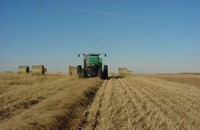Advertisement
Grab your lab coat. Let's get started
Welcome!
Welcome!
Create an account below to get 6 C&EN articles per month, receive newsletters and more - all free.
It seems this is your first time logging in online. Please enter the following information to continue.
As an ACS member you automatically get access to this site. All we need is few more details to create your reading experience.
Not you? Sign in with a different account.
Not you? Sign in with a different account.
ERROR 1
ERROR 1
ERROR 2
ERROR 2
ERROR 2
ERROR 2
ERROR 2
Password and Confirm password must match.
If you have an ACS member number, please enter it here so we can link this account to your membership. (optional)
ERROR 2
ACS values your privacy. By submitting your information, you are gaining access to C&EN and subscribing to our weekly newsletter. We use the information you provide to make your reading experience better, and we will never sell your data to third party members.
Environment
Cellulosic Ethanol Deemed Feasible
Production from farmed switchgrass can surpass energy, environmental, and economic hurdles
by Stephen K. Ritter
January 21, 2008
| A version of this story appeared in
Volume 86, Issue 3

SWITCHGRASS can produce more than enough cellulosic ethanol on a per-acre basis to offset the amount of energy needed to grow and convert the perennial prairie grass into biofuel, according to the first switchgrass modeling study based on large-scale field-trial data (Proc. Natl. Acad. Sci. USA 2008, 105, 464). The study provides a clearer picture of the potential of switchgrass as a biofuel feedstock that can be grown on marginal cropland, the researchers say, where it can provide environmental benefits in addition to energy. What's more, its use may help reduce the amount of corn and other food crops that are being diverted into biofuel production.
One key concern in converting the cellulose in switchgrass, corn, and other crops to ethanol is the net energy value of the conversion. Previous feasibility studies have hinted at switchgrass' potential, but they have been limited because they were based on small research plots, simulated biomass yields, and estimated farming and processing energy inputs.
Kenneth P. Vogel of the Department of Agriculture's Agricultural Research Service office at the University of Nebraska and coworkers now report having collected data over a five-year period from 10 farm sites in Nebraska and North and South Dakota. Farmers grew switchgrass in fields up to 23 acres in size, tracking how much diesel fuel, seed, fertilizer, and pesticides they used, as well as the dry weight of switchgrass harvested each year.
The researchers used the data to calculate the "embodied energy" of each of the inputs that contribute to the total energy cost of producing ethanol. As part of the calculations, they included energy costs of farm labor as well as ethanol product packaging and transportation costs.
The analyzed fields produced on average the biomass equivalent of 320 gal of ethanol per acre, a number the researchers estimated by using a standard reference conversion factor of 0.38 L of ethanol per kg of switchgrass. Cellulosic ethanol will likely be produced by a pretreatment step to free up the cellulose, followed by additional enzymatic degradation to sugars and then fermentation of the sugars into ethanol. Several cellulosic ethanol pilot plants are currently operating, but the first commercial-scale cellulosic ethanol plant is not expected to start running until late 2009 (C&EN, Feb. 19, 2007, page 11).
The switchgrass grown as a bioenergy crop produced 540% more renewable energy than the nonrenewable energy needed to produce it and convert it to ethanol, the researchers state. The study showed that switchgrass ethanol production and use has the environmental benefits of near-zero net greenhouse gas emissions and aids soil conservation relative to typical agricultural crops. And compared with corn, "switchgrass managed as a bioenergy crop in these field trials had estimated ethanol yields similar to those for corn grain grown in the same states in the same years," the researchers write. Advances in plant genetics and agricultural practices "may further enhance energy sustainability and biofuel yields of switchgrass," they add.
The large amount of actual field data presented for switchgrass production systems is a real advance, comments Michigan State University's Bruce E. Dale, a biomass conversion expert. "The study is a carefully done and carefully reported piece of work," Dale says. "It is valuable because the various efficiency metrics are well-defined and the underlying data are disaggregated in such a way as to allow someone to check or compare the data with other assumptions and studies."
But the science of biofuel conversion still has a long way to go, counters Cornell University's David Pimentel, a biofuels expert who believes biofuels' economic and environmental costs outweigh their potential benefits. Pimentel has several concerns about the validity of the Nebraska study's conclusions because the researchers make some assumptions that are not yet verified in practice, such as the conversion rate of switchgrass to ethanol, he says.
There's no easy solution to meeting future energy needs, Pimentel adds. Scientists need to investigate all potential renewable energy technologies and not assume that cellulosic biomass is the only answer, because it realistically can supply only a small fraction of total fuel demand, he says. "A truly thorough examination of biomass and its environmental relationship to water, land, and solar energy is still needed."
Dale and Pimentel squared off in a C&EN Point-Counterpoint feature on the costs of biofuels last month (C&EN, Dec. 17, 2007, page 12). Although they don't see eye to eye on the practicality or benefits of biomass conversion to ethanol, they do agree that the type of detailed study by Vogel and coworkers is needed to advance cellulosic biomass conversion research.



Join the conversation
Contact the reporter
Submit a Letter to the Editor for publication
Engage with us on Twitter